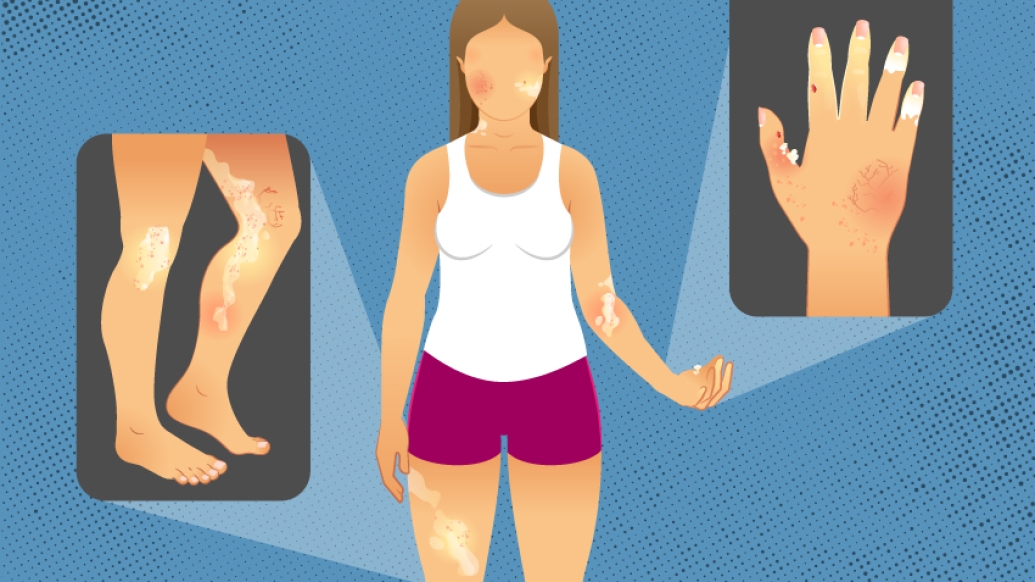A new and novel outcome measure is being used to determine effectiveness of new scleroderma treatments. Learn how Michigan Medicine is leading the way.
1:00 PM
Author |

For patients affected by systemic scleroderma (also known as systemic sclerosis), a chronic autoimmune disease marked by hardening of the skin and internal organ involvement, the need for treatments is well understood.
LISTEN UP: Add the new Michigan Medicine News Break to your Alexa-enabled device, or subscribe to our daily audio updates on iTunes, Google Play and Stitcher.
"Scleroderma has the highest mortality rates of any rheumatic disease," says Dinesh Khanna, M.D., M.Sc., director of the Michigan Medicine Scleroderma Program. "This disease may be rare, but it can have a profound effect on young people and can be quite disabling for patients at any age."
Apart from its effects on the skin, systemic scleroderma can also harden the internal organs. The condition ranges in severity and can cause pain, stiffness and fatigue.
Khanna's program is one of few in the nation dedicated to helping scleroderma patients manage their condition and one of the top three in the nation based on research funding and patient volume.
Although there are currently no approved treatments for the estimated 125,000 people in the United States with scleroderma, Khanna and his team have been spearheading new clinical trials that could help shape the future of care.
He spoke more about efforts and progress.
A new outcome measure for scleroderma
When performing scleroderma treatment trials in the past, Khanna and other experts relied on only one outcome measure: the modified Rodnan Skin Score.
"The score measures skin thickness," Khanna says. "We pinch the skin at 17 different spots and measure skin thickening in patients. It's a primary outcome measure in systemic sclerosis clinical trials."
MORE FROM THE LAB: Subscribe to our weekly newsletter
But, he notes, the skin score had shortcomings. Skin is one aspect of the disease, but scleroderma also affects other organs.
"The scleroderma research field needed a combined measure that captures the overall disease and addresses what is important to a patient," Khanna says.
Which is why he led the development of the American College of Rheumatology Provisional Composite Response Index for Clinical Trials in Early Diffuse Cutaneous Systemic Sclerosis, or ACR CRISS, in 2016.
The two-part measure first examines significant heart, lung and kidney involvement and then changes in baseline in five variables — the modified Rodnan Skin Score (skin thickness); forced vital capacity (a spirometry measurement for lung function preservation); patient global assessment (to measure overall well-being); the Health Assessment Questionnaire Disability Index (a measure of functional disability); and physician global assessment (to assess overall scleroderma).
After examining those variables collectively, the new composite measure calculates the probability of patient improvement after one year of treatment.
The new measure was recently endorsed by the American College of Rheumatology Board of Directors at its 2018 annual meeting to be used in future systemic sclerosis clinical trials.
Scleroderma is a multisystem disease. Novel measures that allow us to capture different aspects of this disease are more meaningful and will hopefully lead to approval of drugs for this condition.Dinesh Khanna, M.D., M.Sc.
Trials investigate scleroderma drug treatments
Khanna recently led two drug treatment trials that didn't demonstrate statistically significant results using the modified Rodnan Skin Score but were still clinically meaningful and had statistically significant changes after examining the results with the ACR CRISS outcome.
In the Phase III trial, focuSSced, patients with active systemic sclerosis — the most serious form of scleroderma — were randomly assigned to receive either weekly double-blind injections of tocilizumab (an immunosuppressive drug mainly for treating rheumatoid arthritis), or a placebo for 48 weeks.
The primary endpoint of change in skin thickness was not statistically significant, Khanna says. When using the ACR CRISS measurement, however, percent predicted forced vital capacity did appear to improve in tocilizumab patients and was driven in preservation of lung function with tocilizumab.
SEE ALSO: Skin's Immune 'Alarm' May Explain Light-Induced Rashes in Lupus Patients
"Lung fibrosis affects many scleroderma patients and we were encouraged to see that the drug appeared to prevent decline in lung function," Khanna says.
He also notes that patient-level data from the trial was analyzed when using ACR CRISS and was statistically significant in favor of tocilizumab.
In his 12-month Phase II ASSET trial, Khanna examined the use of abatacept, a drug generally used in treating rheumatoid arthritis. Patients were either injected with abatacept or placebo every week.
Once again, the trial appeared to not show statistically significant data on the modified Rodnan Skin Score — but when it was analyzed again using the ACR CRISS score, researchers saw new results.
"We found statistically significant changes in the Health Assessment Questionnaire Disability Index, patient global assessment, physician global assessment and the overall ACR CRISS scores," Khanna says. "This translates into how a patient is feeling, and functioning was in favor of the drug compared to placebo."
The future of scleroderma treatments
Khanna says new outcome measures, including ACR CRISS, suggest a promising future for new drug trials aimed at treating scleroderma.
"Scleroderma is a multisystem disease. Novel measures that allow us to capture different aspects of this disease are more meaningful and will hopefully lead to approval of drugs for this condition," Khanna says.
In addition, he and scleroderma collaborators have created a self-management website for scleroderma patients that allows patients to learn more about their condition, manage their symptoms and advocate for their care.
"Managing a chronic disease like scleroderma requires lifelong learning," Khanna says.
He and the Michigan Medicine Scleroderma Program will continue to conduct trials to determine if new drugs could hold promise for treating scleroderma patients.
"There is much more research to come on new treatments for scleroderma, and you can count on our program to help lead this important research," Khanna says.
For more information and to support scleroderma research at Michigan Medicine, please contact our Office of Medical Development at 734-763-6080 or email us.
Dr. Khanna reports consultancy with various ongoing pharmaceutical companies to discover new therapies. These include Actelion, Bristol-Meyers Squibb Company, Bayer HealthCare LLC, CSL Behring, L.L.C., Corbus Pharmaceuticals, Inc., Cytori Therapeutics, Inc., Glaxo Smith Klein, Genentech/Roche, Inc., and Regeneron Pharmaceuticals. He is also medical lead for scleroderma for Eicos Sciences, Inc., a subsidiary of CiVi Biopharma, Inc.

Explore a variety of healthcare news & stories by visiting the Health Lab home page for more articles.

Department of Communication at Michigan Medicine
Want top health & research news weekly? Sign up for Health Lab’s newsletters today!





